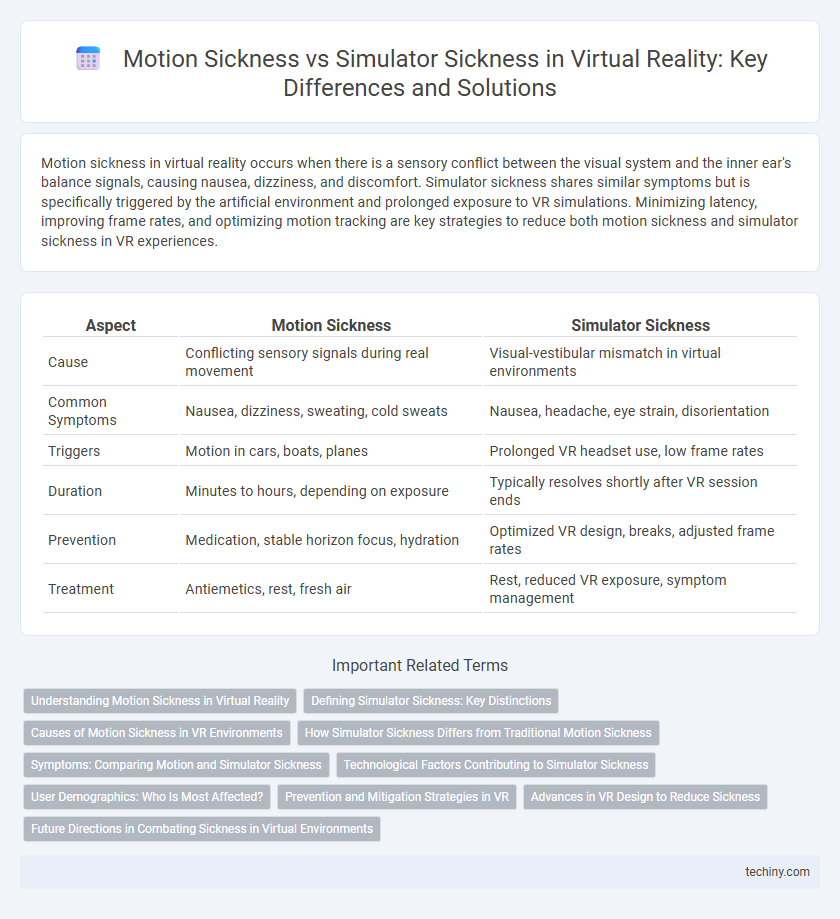Motion sickness in virtual reality occurs when there is a sensory conflict between the visual system and the inner ear's balance signals, causing nausea, dizziness, and discomfort. Simulator sickness shares similar symptoms but is specifically triggered by the artificial environment and prolonged exposure to VR simulations. Minimizing latency, improving frame rates, and optimizing motion tracking are key strategies to reduce both motion sickness and simulator sickness in VR experiences.
Table of Comparison
| Aspect | Motion Sickness | Simulator Sickness |
|---|---|---|
| Cause | Conflicting sensory signals during real movement | Visual-vestibular mismatch in virtual environments |
| Common Symptoms | Nausea, dizziness, sweating, cold sweats | Nausea, headache, eye strain, disorientation |
| Triggers | Motion in cars, boats, planes | Prolonged VR headset use, low frame rates |
| Duration | Minutes to hours, depending on exposure | Typically resolves shortly after VR session ends |
| Prevention | Medication, stable horizon focus, hydration | Optimized VR design, breaks, adjusted frame rates |
| Treatment | Antiemetics, rest, fresh air | Rest, reduced VR exposure, symptom management |
Understanding Motion Sickness in Virtual Reality
Motion sickness in virtual reality arises from sensory conflicts between visual input and the vestibular system, leading to symptoms like nausea and dizziness. Simulator sickness, a subset of motion sickness, specifically occurs during VR use due to discrepancies between perceived motion and actual physical movement. Understanding these physiological and neurological responses is essential for designing VR experiences that minimize discomfort and enhance user comfort.
Defining Simulator Sickness: Key Distinctions
Simulator sickness refers to symptoms such as nausea, dizziness, and disorientation experienced during or after exposure to virtual environments, typically caused by sensory conflict between visual input and vestibular signals. Unlike motion sickness, which arises from actual physical motion, simulator sickness occurs without real movement, often triggered by latency, low frame rates, or mismatched motion cues in VR systems. Understanding these key distinctions helps developers optimize hardware and software to minimize discomfort in virtual reality experiences.
Causes of Motion Sickness in VR Environments
Motion sickness in VR environments primarily arises from sensory conflict between visual inputs and the vestibular system, where the eyes perceive motion but the body remains stationary. Factors such as lagging frame rates, low refresh rates below 90Hz, and mismatched visual cues exacerbate the discrepancy causing disorientation and nausea. Inconsistent field of view, latency issues, and improper calibration of head tracking further intensify motion sickness symptoms during virtual reality sessions.
How Simulator Sickness Differs from Traditional Motion Sickness
Simulator sickness primarily arises from visual-vestibular conflicts within virtual reality environments, where the eyes perceive motion that the inner ear's balance system does not detect. Traditional motion sickness, by contrast, typically occurs during physical movement such as in cars, boats, or airplanes, where there is a direct mismatch between motion sensed by the inner ear and visual cues. This fundamental difference highlights how simulator sickness is more strongly tied to sensory input discrepancies created by VR headsets rather than actual physical motion.
Symptoms: Comparing Motion and Simulator Sickness
Motion sickness and simulator sickness both cause nausea, dizziness, and sweating, but their symptoms differ in onset and triggers. Motion sickness arises from real-world movement conflicts between the inner ear and vision, often leading to cold sweats and vomiting. Simulator sickness results from visual-vestibular mismatch in virtual reality environments, causing headaches, eye strain, and disorientation without actual motion.
Technological Factors Contributing to Simulator Sickness
Technological factors contributing to simulator sickness include low frame rates, latency between user movements and visual updates, and mismatches between motion cues and visual input. Inadequate display resolution and limited field of view can also exacerbate symptoms by reducing immersion and causing sensory conflicts. Advanced tracking systems and optimized rendering algorithms help minimize these discrepancies, reducing the incidence of simulator sickness in virtual reality environments.
User Demographics: Who Is Most Affected?
Motion sickness in virtual reality predominantly affects users sensitive to vestibular disturbances, often including women, children, and those with a history of migraines. Simulator sickness is more common among individuals with less experience using VR technology and older adults, as their visual-vestibular sensory integration may be less adaptable. User demographics such as age, gender, and prior VR exposure play crucial roles in susceptibility to both motion sickness and simulator sickness.
Prevention and Mitigation Strategies in VR
Preventing motion sickness and simulator sickness in VR involves optimizing frame rates to exceed 90 FPS and reducing latency to less than 20 milliseconds, which enhances visual stability and responsiveness. Implementing stable horizon cues and minimizing unnatural motion through user-controlled navigation reduces sensory conflict, a primary cause of discomfort. Employing gradual acclimatization protocols and providing real-time user feedback helps users adapt to VR environments, significantly mitigating symptoms of discomfort.
Advances in VR Design to Reduce Sickness
Recent advances in VR design have significantly reduced motion sickness and simulator sickness by improving head-tracking accuracy and minimizing latency to enhance user comfort. Techniques such as foveated rendering and adaptive frame rates optimize visual fidelity while reducing sensory conflicts that cause discomfort. Ergonomic headset designs combined with personalized motion profiles further decrease vestibular mismatch, leading to longer and more comfortable VR sessions.
Future Directions in Combating Sickness in Virtual Environments
Future directions in combating motion sickness and simulator sickness in virtual environments emphasize integrating advanced sensory feedback systems and adaptive algorithms that personalize user experiences based on real-time physiological data. Research focuses on machine learning models capable of predicting onset of discomfort, enabling dynamic adjustments in visual and vestibular stimuli to minimize symptoms. Innovations include vestibular prosthetics and multimodal sensory synchronization techniques to enhance immersion while reducing adverse effects in prolonged virtual reality sessions.
motion sickness vs simulator sickness Infographic

 techiny.com
techiny.com